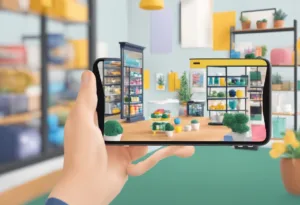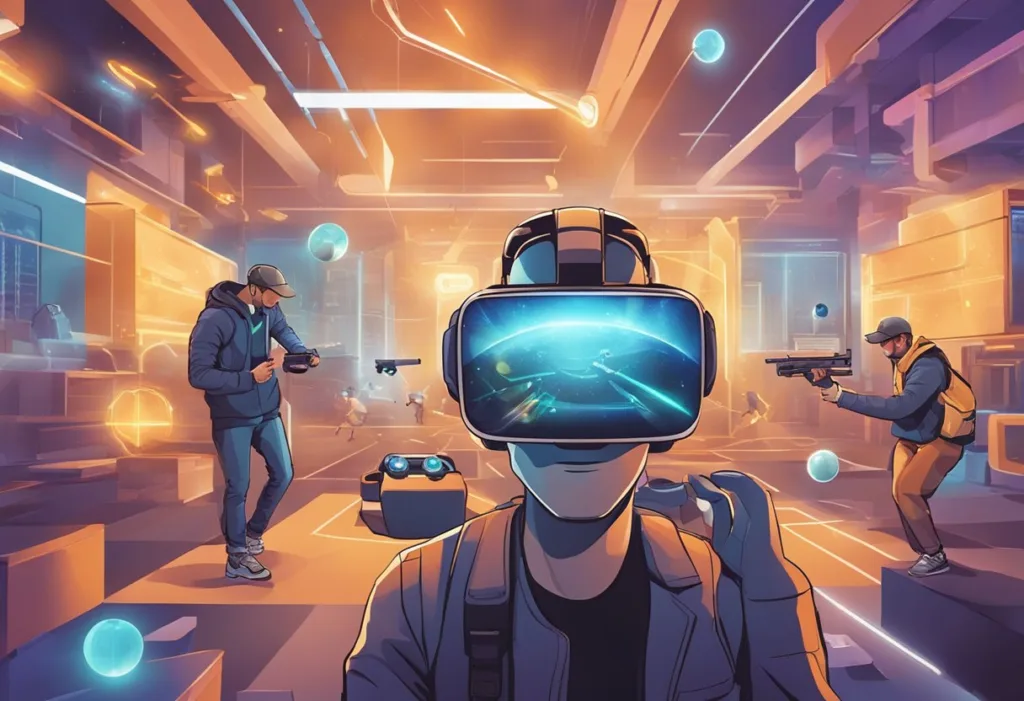Augmented reality (AR) is a technology that merges digital information with the real world, creating an interactive and immersive experience for users. AR has been making waves in the ecommerce industry, enhancing the customer experience and driving sales. In this blog post, I will share with you 10 use cases of augmented reality in ecommerce and AR can enhance your business.
The evolution of AR in ecommerce has been remarkable. With the advancement of technology, AR has become more accessible and affordable, making it possible for small and large businesses to integrate it into their ecommerce strategy. AR has been used in various industries such as interior design, fashion, and beauty, allowing customers to try on products virtually and visualize how they would look in real life. By offering a more realistic and personalized shopping experience, AR has been shown to increase customer engagement, reduce returns, and ultimately drive sales.
The Evolution of AR in Ecommerce
Augmented reality (AR) has emerged as a game-changing technology with the potential to revolutionize various industries, including retail and ecommerce. AR technology has been around for a while, but it has only recently gained significant attention from businesses and consumers alike. In this section, you will learn about the evolution of AR in ecommerce, from virtual reality to augmented reality, and how AR technology works in ecommerce.
From Virtual Reality to Augmented Reality
Virtual reality (VR) and augmented reality (AR) are often used interchangeably, but they are not the same. VR is a fully immersive experience that transports the user to a completely different world, while AR overlays digital information onto the real world. VR has been around for decades, but it has not gained widespread adoption due to its high cost and limited accessibility. On the other hand, AR has been gaining popularity due to its ability to enhance the user’s real-world experience.
How Augmented Reality Works in Ecommerce
AR technology allows customers to visualize products in their own environment before making a purchase. By using their smartphone or tablet, customers can view 3D models of products in their own space, allowing them to get a sense of how the product will look and fit before making a purchase. This technology has become increasingly popular during the COVID-19 pandemic, as customers are unable to visit physical stores and try on products.
AR technology can also enhance the customer experience by providing additional information about the product, such as reviews, ratings, and specifications. By providing this information, customers can make more informed decisions about their purchases.
AR technology has come a long way since its inception and has the potential to revolutionize the ecommerce industry. By providing customers with a more immersive and informative experience, businesses can increase customer satisfaction and drive sales.
Augmented Reality In Ecommerce: 10 Use Cases

Here are 10 use cases of augmented reality in eCommerce:
- Virtual try-ons for clothing and accessories
- Preview placement of furniture and home decor in a space
- Interactive product manuals and demonstrations
- Virtual showrooms and product launches
- AR-enhanced navigation in physical stores
- Personalized product recommendations with AR
- Interactive and engaging advertising campaigns
- Real-time product customization and previews
- AR for product assembly and installation guides
- Enhanced brand storytelling and customer experiences
Virtual Try-Ons for Clothing and Accessories
The use of augmented reality for virtual try-ons has revolutionized the way customers shop for clothing and accessories online. By leveraging AR technology, eCommerce platforms allow users to see how certain items will look on them without the need to visit a physical store.
This feature utilizes the user’s camera to superimpose digital images of clothing items onto their live image or avatar, giving a realistic depiction of fit, style, and color. Virtual try-ons reduce the guesswork involved in online shopping, leading to increased customer satisfaction and reduced return rates. It also enables shoppers to experiment with different styles, encouraging them to explore a wider range of products.
Preview Placement of Furniture and Home Decor in a Space
Augmented reality enables customers to visualize how furniture and home decor items would fit and appear in their actual living spaces. This is particularly useful for large items like sofas, tables, or shelving units, where size and spatial dimensions are crucial.
Customers can use their smartphones or tablets to place virtual models of the products they are considering buying in their room, allowing them to assess the size, design, and compatibility with their current layout and decor. This functionality helps in making more informed purchasing decisions, reducing the likelihood of returns due to size or style mismatches.
Interactive Product Manuals and Demonstrations
AR transforms traditional product manuals into interactive, easy-to-follow guides. Instead of flipping through pages of instructions, customers can use their device to scan the product, and AR technology overlays digital instructions onto the physical item.
This can include step-by-step assembly, usage guidelines, or feature demonstrations, providing a hands-on learning experience. Interactive manuals not only enhance customer understanding of the product but also significantly improve the post-purchase experience by simplifying the setup process.
Virtual Showrooms and Product Launches
eCommerce businesses are utilizing AR to create virtual showrooms and product launches, allowing customers to explore new products from the comfort of their homes. These virtual environments can be accessed through a smartphone, tablet, or AR headset, providing an immersive experience that closely mimics visiting a physical store or event.
Customers can interact with products, view them from different angles, and learn about features and specifications through interactive hotspots. Virtual showrooms expand the reach of product launches and can drive excitement and engagement without geographical limitations.
AR-Enhanced Navigation in Physical Stores
Incorporating AR into physical retail spaces offers a unique way to blend online and offline shopping experiences. Customers can use their devices to navigate through stores with AR-powered maps, find products quickly, and access detailed product information by scanning items. This can enhance the in-store experience by providing a personalized and efficient shopping journey, improving customer satisfaction, and potentially increasing sales.
Personalized Product Recommendations with AR
Augmented reality can be used to offer personalized product recommendations to shoppers. By analyzing a customer’s preferences and previous interactions, AR technology can suggest items that the customer might like or need. When customers view products through their device’s camera, AR can highlight recommended products, show how they could be used, or even suggest complementary items. This personalization enhances the shopping experience and can lead to higher conversion rates.
Interactive and Engaging Advertising Campaigns
AR technology allows brands to create interactive and engaging advertising campaigns that stand out in a crowded marketplace. Customers can interact with AR-enabled ads by scanning images or objects in the real world, which then trigger an immersive experience such as a game, a virtual product demonstration, or an interactive story. These campaigns not only capture the attention of potential customers but also encourage them to spend more time with the brand, increasing the likelihood of a purchase.
Real-Time Product Customization and Previews
Customers can use AR to customize products in real time and instantly preview their creations. For items like sneakers, watches, or even cars, AR allows consumers to change colors, patterns, or features and see how these customizations look on the actual product. This interactive process not only enhances customer engagement but also allows them to make more confident purchasing decisions, knowing that the product will meet their specific preferences.
AR for Product Assembly and Installation Guides
Augmented reality provides an intuitive way for customers to assemble or install products with real-time guidance. By overlaying digital animations and instructions onto the physical components through a device’s camera, AR helps users understand exactly where each part goes and how to perform each step of the assembly process. This reduces frustration and the time it takes to complete the task, improving the overall customer experience.
Enhanced Brand Storytelling and Customer Experiences
AR technology enables brands to tell their stories in a more compelling and immersive way. By creating interactive experiences that customers can access through their devices, brands can convey their values, mission, or the unique attributes of their products. These experiences can range from virtual tours of the brand’s facilities to storytelling that showcases the brand’s heritage or the benefits of their products. Enhanced storytelling through AR can lead to deeper emotional connections with customers and a stronger brand image.
Enhancing Customer Experience with AR

Augmented Reality (AR) is transforming the way ecommerce businesses interact with customers. AR offers an immersive and engaging experience that allows customers to virtually try on products, interact with user manuals, and visualize products in 3D.
Virtual Try-On Solutions
AR technology allows customers to virtually try on products before making a purchase. This technology offers an innovative and convenient solution for customers who want to see how a product looks on them before making a purchase. AR-powered virtual try-on solutions are available in AR apps and are accessible through smartphones and other electronic devices.
Interactive User Manuals
AR technology makes user manuals more interactive and engaging. With AR-powered user manuals, customers can scan a product and view a 3D model of the product with interactive instructions on how to use it. This technology offers a more immersive and engaging experience that makes it easier for customers to understand how to use a product.
Immersive Product Visualization
AR technology allows customers to visualize products in 3D. This technology offers an immersive and engaging experience that allows customers to see how a product looks in different environments. AR-powered product visualization is available in AR apps and is accessible through smartphones and other electronic devices.
AR technology offers an innovative and convenient solution for ecommerce businesses to enhance the customer experience. AR-powered virtual try-on solutions, interactive user manuals, and immersive product visualization are just a few examples of how AR technology is transforming the way customers interact with products.
AR’s Role in Conversion and Sales

Augmented Reality (AR) technology is revolutionizing the way customers shop online. By enabling customers to visualize products in their own environment, AR is transforming the online shopping experience. In this section, we will explore the role of AR in conversion and sales, and how it can help businesses increase conversion rates and reduce product returns.
Increasing Conversion Rates
AR technology can significantly increase conversion rates for ecommerce businesses. By allowing customers to visualize products in their own environment, AR helps them make more informed purchasing decisions. This leads to higher conversion rates, as customers are more likely to purchase products that they can see in their own space.
According to a report by ARtillery Intelligence, consumer spending influenced by AR is expected to reach $58 billion by 2025. This demonstrates the value of AR technology to ecommerce businesses, and the potential for increased conversion rates.
Reducing Product Returns
Product returns are a major challenge for ecommerce businesses. They can be costly and time-consuming, and can negatively impact customer satisfaction. However, AR technology can help reduce product returns by enabling customers to visualize products in their own environment before making a purchase.
In addition, AR technology can also help reduce product returns by providing customers with more accurate product information. By using AR to display product information, such as dimensions and materials, customers can get a better understanding of the product before making a purchase.
AR technology has the potential to significantly impact conversion rates and sales for ecommerce businesses. By enabling customers to visualize products in their own environment, AR can help increase conversion rates and reduce product returns. As AR technology continues to evolve, it will become an increasingly important tool for ecommerce businesses looking to improve their online shopping experience.
Challenges AR Integration in Ecommerce
Augmented Reality (AR) integration in ecommerce presents several challenges and considerations that businesses must take into account before implementation. Below are two of the most significant challenges and considerations you need to be aware of.
Technical and Hardware Limitations
AR requires high-quality hardware and software to function correctly. This can be a significant challenge for businesses, especially small and medium-sized enterprises (SMEs), as the cost of acquiring such hardware can be prohibitive. The technology required to run AR is continually evolving, meaning that businesses must be prepared to upgrade their hardware and software regularly.
To mitigate this challenge, businesses should consider partnering with AR technology providers who can offer affordable and scalable solutions. Businesses should consider investing in hardware and software that can support AR implementation in the long term.
Balancing Immersion and Practicality
AR should be immersive enough to provide an engaging shopping experience, but it should also be practical enough to ensure that customers can complete transactions quickly and efficiently. Finding the right balance between immersion and practicality can be challenging, as too much immersion can lead to a slow and frustrating shopping experience, while too much practicality can make the shopping experience dull and uninspiring.
To overcome this challenge, businesses should focus on creating an AR experience that is both immersive and practical. This can be achieved by providing customers with relevant and engaging information about the products they are interested in, as well as offering them easy-to-use tools that allow them to complete transactions quickly and efficiently.
AR integration in ecommerce presents significant challenges and considerations that businesses must take into account. By addressing technical and hardware limitations and finding the right balance between immersion and practicality, businesses can create an AR shopping experience that is both engaging and efficient.
AR in Ecommerce: Strategies for Success
Augmented Reality (AR) is becoming increasingly popular in the world of ecommerce. Businesses are recognizing the potential of AR to enhance customer engagement, boost sales, and increase brand loyalty. In this section, we will discuss some strategies for successfully implementing AR in your ecommerce business.
Marketing and Customer Engagement
AR can be a powerful tool for marketing and customer engagement. By leveraging AR, you can provide customers with an immersive shopping experience that allows them to interact with your products in a way that was previously not possible. This can help to increase customer engagement and encourage them to make a purchase.
One effective way to use AR for marketing is to create interactive product demos. By allowing customers to see how your products work in real-time, you can increase their confidence in your products and make them more likely to buy. You can also use AR to create engaging marketing campaigns that capture the attention of your target audience.
Leveraging Social Media Platforms
Social media platforms are an excellent way to reach a large audience and promote your AR-powered ecommerce business. By leveraging platforms like Facebook, Instagram, and Snapchat, you can create engaging content that showcases your products and encourages customers to make a purchase.
One effective way to use social media for AR-powered ecommerce is to create AR-powered ads. These ads can be used to showcase your products in a way that is both engaging and informative. You can also use social media to promote your AR-powered products by sharing user-generated content and encouraging customers to share their experiences with your products.
AR is an exciting technology that has the potential to revolutionize the world of ecommerce. By implementing the strategies discussed in this section, you can successfully leverage AR to increase customer engagement, boost sales, and increase brand loyalty.
Frequently Asked Questions
How is augmented reality used in eCommerce?
Augmented reality (AR) is used in eCommerce to enhance the customer’s shopping experience. It allows customers to see a virtual representation of the product they are interested in, which helps them make informed purchasing decisions. AR can also be used to provide customers with additional information about the product, such as specifications, reviews, and related products.
What is the future of augmented reality in eCommerce?
The future of augmented reality in eCommerce is bright, as it is becoming increasingly popular among customers and businesses alike. It is projected to become a $250 billion industry by 2028. As technology continues to advance, AR will become even more accessible and user-friendly, making it an essential tool for eCommerce businesses.
What are the challenges of AR in eCommerce?
One of the biggest challenges of AR in eCommerce is ensuring that it is user-friendly and accessible to a broad audience. This requires attention to device compatibility, user interface design, and the learning curve for using AR functionalities. Businesses must ensure that their AR features are accurate and reliable, as inaccurate representations of products can lead to customer dissatisfaction and returns.
How does Amazon use augmented reality?
Amazon uses augmented reality in a variety of ways, including its “View in Your Room” feature, which allows customers to see how furniture and other products will look in their homes before purchasing. Amazon also uses AR to provide customers with additional information about products, such as 360-degree views, product details, and customer reviews.
How does Ikea augmented reality work?
Ikea’s augmented reality works by allowing customers to use their smartphones or tablets to see how furniture and other products will look in their homes. Customers can use the Ikea Place app to select products and place them in their desired location, allowing them to visualize how the product will fit into their space.
What is AWS augmented AI?
AWS augmented AI is a set of machine learning tools and services that allows businesses to integrate AI into their applications and workflows. It includes tools for image and video analysis, natural language processing, and speech recognition, among others. By using AWS augmented AI, businesses can improve their customer experience, automate processes, and gain insights into their data.














